Welcome, fellows! It’s time for another one of these long, rambling communications that I spend way too much time on each week. This time out, I’d like to begin by reprinting a spiel that I made to the Marvel editorial team in the course of the last week, concerning Stories and where our eye should be on the contents of every issue we publish.
Having read a bunch of our comics recently and had a thought about them, I want to spend a could of minutes talking about story and about each individual comic being a complete unit of entertainment.
The reason I bring this up is that I feel like I'm seeing a rise of comics that we have coming out that don't actually contain a story, just a bunch of scenes. Not everything by any means, but enough to concern me.
So here's the thing: while we certainly do a lot of 6-part or 5-part and now 4-part storylines, our basic unit is still the individual comic book.
That unit is a $3.99 investment, and that cover price is going up. So it's up to us to provide the audience with equivalent value for their money and time--that's how we get them hooked and keep them hooked.
Part of making that buy-in worthwhile is for each individual comic book to contain an actual story and to feel satisfying as a reading experience--even if it's a part of a multi-issue saga.
So, what is a story in this context? Well, the simplest I can reduce it down to in terms that are easy to understand is that it's a situation in which the character faces a conflict and achieves some measure of resolution.
It's that last bit that we're maybe falling down on.
Now, this doesn't mean that every story needs to be one issue long. But it does mean that every issue should contain some resolution of some kind--even (and especially) if that resolution then pushes the characters forward into their next conflict in the course of the story.
Conflicts don't need to be physical fights, they can be problems, emotional questions, relationship issues, etc.
I feel strongly that if we focus on making sure that every issue has some conflict resolution--some story--that our books will begin to sell better, because each issue will be more subliminally satisfying to the audience. They won't know why necessarily, it'll just be that way.
A good, simple litmus test: if you try to describe the story in a give issue of your book and it's something like, "Hero continues his search for villain", congratulations, you don't have a story.
We need to be mindful of looking for this stuff at the script stage, and pushing back to our writers.
Every issue of every book should move the ball down the filed in some meaningful fashion.
Thanks for coming to my TED talk. Get home safely.
Elsewhere, I’ve now sent off what I expect to be the last of my old business cards to Newsletter subscribers who wanted one, And thanks, everybody, for the nice little notes and cards that were included along with the mandatory S.A.S.E. But to the one person who saw this as an opportunity to send me story samples, I’m sorry, but I had to discard those unlooked at. Marvel doesn’t accept unsolicited submissions of any kind, and the rules are sticky enough that I can’t even look at them. So in the future, don’t do this. It’s a waste of time for both of us, and it’ll make both of us feel bad knowing that the material in question simply got thrown away.
Anyway, we had a bunch of questions again this week, so let’s get into that with some hopefully more positive results:
Paul Constant
Since you mentioned him, I’m curious about your opinions of Jim Shooter’s post-Marvel output. I really enjoyed Valiant at the time. I recently revisited the Defiant line, and I think it was one of the most promising attempts at world building I’ve ever seen in comics.
I’ve followed most of Jim’s post-Marvel output to some degree—I was one of those who bought MAGNUS #1 off the racks at the beginning of Valiant and who gave at least a fair chance to all of the later Defiant and Broadway Comics titles. And even Jim’s more recent Gold Key revival at Dark Horse. And there’s a lot to like in all of these different lines. But there are also some weird choices. Jim developed a style of structuring an issue in a very personal fashion, almost like an anti-Marvel approach. His stories largely don’t build to any specific cliffhanger moment, most often the issues just seem to stop at an almost random point. I’m reminded in some ways of Jack Kirby’s 1970s output, about which I’d sometimes feel the same way—like Kirby simply kept writing until he ran out of pages, and then arbitrarily stopped. Now, this did give those books a genuine flavor of their own, and it was a fascinating way of going about things to me. That said, I don’t know that it worked out all that great in hindsight. I find that as I cast my mind back, it’s difficult to pull out specific individual issues of the different titles Jim had worked on. The series as a whole all made an impression, but I can’t point to, say, issue #4 as being a really spectacular issue or story. Might just be me and my taste rather than any fault of Shooter’s, though. During the brief moment when we almost did an AVENGERS project together, at one point I made reference to this and encouraged him to approach the series with a similar mindset, and he seemed confused by the suggestion. Possibly I didn’t express it well, possibly it wasn’t something that he ever considered at all from the angle I was coming at it from.
Zack J
Curious how you manage things when multiple books have similar concepts. For example the latest volumes of Hulk, Amazing Spider Man and Fantastic Four started with the protagonist being hated by people at large because of some mystery event. Or Moon Knight and Scarlet Witch both opening with the protagonists working in a new location as a neighbor hero working in their community. Or the Avengers Celestial base coming alive and being a significant part of both AXE and Avengers Assemble. When is an idea too similar to something you have in the works and when is it alright to have overlap?
I think it depends on just how similar you feel the ideas are, Zack. If we think they’re too close, then we’ll go in some other direction and you’ll never know that they were even considered except in insider Newsletters like this one. But of the examples you laid out, coming at this on FANTASTIC FOUR, it never once crossed my mind that this was in any way too similar to Zeb’s AMAZING SPIDER-MAN or Donny’s HULK. As soon as the first issue came out, though, every fan on Earth remarked about it, so clearly that was an area where I didn’t see how invested readers had been in those previous two mysteries, which to my eyes had been largely back-burnered by that point. It also may have been that the central idea in that FANTASTIC FOUR mystery had been a thing that I had brainstormed with Mark Waid two decades earlier for a different purpose (which is why he got a special thanks in issue #4) so it had been initially developed apart from what was going on contemporaneously in those other titles. In the case of MOON KNIGHT and SCARLET WITCH, when the latter came forward with their premise concept, I didn’t think it covered the same ground as the Midnight Mansion at all, so again, the question never came up. And in the case of Avengers Mountain, Jason Aaron had introduced the place originally with the intention that it would become animated by Deathlok in the finale—that was the plan for a long time. But when we decided to do an Event series that united the Avengers, X-Men and Eternals, the fact that the Avengers were operating out of a Celestial was too great a piece to ignore or overlook as a part of the plotting. So we coordinated as best we could between Jason and Kieron to make sure that both stories got what they needed without fouling things up for the other creator.
Grant
Just a thought, but why not ask if Jon & Adi are interested in finishing IRON MAN: VIVA LAS VEGAS? If they are, you could just release the whole thing, issues 1 through 4, as a hardcovered graphic novel. Seems like the interest would be there, regarding sales...
As I said last week, Grant, the idea of completing the work has come up a couple of times over the years, but nobody involved is especially interested in revisiting it at this point.
Chris Sutcliffe
I first heard your name when it came attached to a manifesto about who Spider-Man should be post-One More Day, and what the core of his character is. I believe this was you then working as editor for this run.
I'd love for you to talk on that, how you feel about what you said now, in hindsight, especially seeing how fixated on One More Day some fans have become. Do you agree with past-you's approach?
But more specifically, I'd love to know more about the writer's room approach you mentioned.
So many writers struggle writing Amazing Spider-Man because of the bi-weekly schedule and your approach seems like a good way to fix that. I know that a Spidey Brain Trust happened, so I'd love to know what worked well about that approach and why it ended up back as a single writer.
Well, Chris, I haven’t looked at that document in many years, but I don’t think that many of my opinions regarding Spider-Man and what the strip’s narrative engines are all about have changed much in that time. There might be other things that I would highlight today, some elements that I might position differently a little bit, but by-and-large, I still hold to what I laid out back then. I completely get that certain fans are fixated on the events of One More Day, as we knew some of them would be. But especially after seeing DC blink after having undone the Superman & Lois marriage and restored it, I certainly wouldn’t change things now or going forward. It was a painful thing to do, one that Joe Quesada bore much of the brunt of—but now that it’s been accomplished, it would be the height of foolishness to turn around and go back down into that hole again. In terms of the Spider-Man Braintrust/Web-Heads, first off all, while I wrote up that position paper, it was actually editor Stephen Wacker who directly edited AMAZING SPIDER-MAN and the other Spidey books during this period. So anything that worked there—and there was a bunch of it—should really be attributed to him. And in practical terms, it was a difficult thing to do, juggling a team of writers over the course of a few years to put out three consecutive issues of the same series every month, containing subplots and rising actions and coordinated casts and get everybody’s ideas and points of view represented. But Steve was extremely good at it. He’d had experience from having worked on DC’s 52 which I think helped—he wasn’t beginning from the absolute ground floor. All that said, it was tough. So tough that at a certain point, the decision was made to go down to only two issues being released every month and bringing in a single writer for all of it, which turned out to be Dan Slott. And that’s more or less how it’s been ever since, excepting the recent period where Nick Lowe did the SPIDER-MAN BEYOND storyline and again utilized a team of writers to produce storylines in tandem. Nick did it for a much shorter time than Steve did, and he seemed to have some success with it. But it’s definitely harder to work that way than it is with just a single writer (even if you occasionally need to bring in somebody else to do an issue or two, as Joe Kelly did recently.)
Mortimer Q Forbush
Who facilitates translations when an English-speaking writer is working with an artist that doesn't speak English? How much does this impact the production schedule?
In virtually every case, if there’s a creator who doesn’t speak English, then they have somebody working with them who is fluent and who can interface with Marvel. Without such a person in place, it would be difficult to get hired in the first place. So most of the time, this falls into the hands of the creator, whether the person is an agent, a spouse, a friend or simply a Google translate program. And for sure this can cause difficulties from time to time—especially when writers use idioms in their scripts. (Memorably, in an X-MEN issue once, Ed Brubaker had Warpath on a spaceship, moping about his problems on a secluded deck. But when the page came in drawn, the artist had drawn Warpath with a mop in hand, mopping the deck. This is far from an infrequent occurrence. )
Mike
I am interested in your thoughts about what I would call “fan impatience”, it seems that (and maybe it’s only on the internet), that readers are critical before a storyline is complete. Then it seems to be about what’s next. I’d imagine it can be discouraging at times and do editors and creators speak about this?
I think there’s certainly truth to what you’re suggesting here, Mike, though I don’t think it’s specific to just comics. I think especially the fan audience has grown so jaded and familiar with many of the tropes of storytelling that they’re prepared to decry anything that they don’t like. Save me from cries of “filler episode” —we used to just call them stories. By that same token, the people who are complaining are clearly not getting what they want out of the experience. They aren’t satisfied by the product. And so, while it’s easy to put all of the onus on them, it’s also healthy to stare a bit at what you’re doing, to make sure that your stories are actually substantive. That’s what that whole spiel I posted at the start is about doing. And it’s clear that, especially in instances of big, potentially status quo-shaking storylines, the audience tends to get nervous about them while they’re going on and expecting the worst. Brian Bendis and I would sometimes talk about how most of the crossovers and big stories we worked on together were hated while they were coming out but thereafter almost universally embraced once they were finished and the outcome was known. In other words, readers were much more willing to sit back and enjoy the ride once they felt secure that the ride would eventually come to a full and complete stop.
Kevin S
I'll pivot to ask how the idea for homage covers typically arises... Does the artist ask to do it? Is it an editor's request? And are there any considerations for what might be "off limits"?
As a general rule, Kevin, I don’t love homage covers, though the audience certainly seems to. I don’t have any problem stealing from the past, I do it all the time on covers, but I prefer to build off of an established idea rather than pick up an earlier artist’s composition. But they can be suggested by the artist (and often are) or suggested by the editor (and often are) or even requested specifically by the Sales department or the Editor in Chief. There’s always a concern about overdoing any one classic cover image, doing too many homages of the same thing, and that may result in a particular image being considered off-limits for a time. But those sorts of bans never last forever, and the only stuff that tends to be out of bounds is when you’re homaging an image from somewhere else that Marvel may not have the rights to emulate.
Jeff Ryan
Trade paperback question: Sometimes a collection's title will be that of the multi-issue story it collects. Sometimes it'll just be the book's title and Vol 1. Sometimes it'll include the name of the creatives. And sometimes the name will be original, and not the title of any story in the collection. Who decided how a trade paperback gets named?
Depends on the circumstances and the stories contained. But most titles come from the creators and the editors. In certain cases, a decision is made to title the collections differently from the individual issues. For example, on MOON KNIGHT, Jed decided that he’d like to name each volume after a different Ramones song. There’s also a need to be able to separate one run from the next, especially given how often our books tend to restart our numbering. So you can really only do AVENGERS Vol. 1 once. After that, it’s typical that you wind up naming the subsequent runs after the writer (because they tend to be the creative element represented in the most issues) such as AVENGERS by JASON AARON Vol 1. Which sucks if you’re an artist, but unless your name is Mark Bagley or Salvador Larroca, you’re likely not going to be able to produce quickly enough to be on the majority of issues in every collection.
Peter Hohman
Not that anyone asked for this, but it seemed natural that someone needs to define the platonic DC artist of each era as well. The 60s and 70s are easy for me, but every other decade gives me a lot of trouble...
1940s - Jerry Robinson?
1950s - Wayne Boring? Dick Sprang?
1960s - Carmine Infantino
1970s - Neal Adams
1980s - George Perez? Young Keith Giffen?
1990s - Weird answer, but I'm going to go with Richard Case, who drew an issue of almost every big Vertigo book and embodied the more offbeat approach to superhero art that DC seemed to embrace at the time. Otherwise maaaybe Howard Porter
2000s - Scott Kolins or Jim Lee
2010s - probably Capullo
This is a nice list, Peter, though I of course disagree with some of it. In particular, I tend to think the platonic ideal artist look of the 1940s at DC was more likely somebody like Jack Burnley. The preferred DC look of the 1950s was the clean, open style of Dan Barry. And I would say that the platonic ideal artist of a 1990s DC comic book was Dan Jurgens. Jim Lee, though, was definitely the 2000s.
Get_It_Away
Your post about Fraction/Larroca's Invincible Iron Man got me thinking, can you think of another Marvel book (or even DC) in the last 15 years that had 1 creative team do that many consecutive issues? Not only did they not miss a month, they knocked out 63 issues in 4 1/2 years. On top of it, Sal did every cover. I guess the previous record might be Bendis and Bagley on USM, but I hadn't looked back to see if there were any fill in artists along the way.
I had remembered Salva missing at least one issue during that time, but I’m likely thinking of the Mandarin-themed Annual that came out during that run. But, yeah, it was a very consistent and long-running series. And, as tends to be the case for these things, by and large the audience didn’t care especially. The book was always well received, but Matt and Salvador weren’t especially called out for this consistency, at least as I recall things. It’s always a bit frustrating when fans speak about wanting long runs by a consistent team “like we had in the old days”, but when you get a situation like that, it goes underappreciated. But then, the heart wants what it wants, right? Anyway, I believe you’re correct, I don’t think there’s been another run of that duration since. SILVER SURFER by Dan Slott and Mike Allred went 29 issues and a preview story, but that isn’t quite in the same league.
Behind the Curtain
Hey! Here’s your chance to be like Marvel’s legendary art director John Romita!
See that cover above? Nice piece, right? Well, there’s something wrong with it. Something that was the bane of John Romita’s existence, that gave him more headaches and heartaches than just about anything else. It’s a tiny thing, but once you see it, you can’t unsee it. I worked alongside John for about seven years before he retired, and in doing so, he sensitized me to the same sorts of errors. So when this cover was coming through production the other day, it set off John Romita bells in my head. So do you see it? Can you spot the problem? Go on, give it a try, then scroll on.
Did you get it? I’m guessing that most of you didn’t. It’s the way that Spidey’s foot interfaces with his web line. See, Spidey’s hand is behind his foot, but somehow the web line was passing in front of it. This sort of thing seems minor but it subliminally flattens out and screws up the depth of the image by introducing an element of incongruity into it. A proper image is organized, with each element occupying its own position in space in relation to every other element. Screw that up, and you wind up with a cover that isn’t as effective as it might be. As art director and cover editor, this was something that John Romita drilled into a bevy of artists and editors over the years. He definitely hyper-sensitized me to tangents and picture plane problems of this nature. So above is the quick bit of corrective surgery I whipped up to show people what I was talking about. I believe this’ll be fixed by the time it makes it into print. .
Pimp My Wednesday
Big week for my office, with big books in the offing! So here’s what they look like!
It’s the beginning of a new era for AVENGERS with the oncoming creative team of Jed MacKay and C.F. Villa. We aren’t really reinventing the wheel here so much as refocusing the series on the fundamentals and then pushing it to the limit. It’s a really good first issue, including what I now think of as the modern day definition of who and what the Avengers are. Here’s a hint; they’re not cops. And hey, it’s also great to have the excellent Stuart Immonen providing covers on the series!
At the same time, FANTASTIC FOUR hits the celebratory issue #700 this week, with an oversized issue from your regular creative team of Ryan North and Iban Coello. Iban worked on this issue up to and through the birth of his son, so if the pages are a bit more drenched in drool than usual, you’ll understand why. It’s a big one, as we get the new FF headquarters and a confrontation with perennial nemesis Doctor Doom, who is approached in the typical Ryan North style. Which is to say, it’s smart and clever and fun.
And Annalise Bissa has the fourth issue of BLOODLINE: DAUGHTER OF BLADE hitting the stands, from Danny Lore and Karen Darboe. The preliminaries are over, so it’s now time for Brielle Brooks and her father to come to grips with just what is going on in Atlanta.
And over in AVENGERS UNLIMITED, the Avengers and Guardians story continues to roll on, courtesy of David Pepose and Ze Carlos. This time out, it’s up to Rocket and Groot and Ant-Man to pull off a heist in a securely-guarded vault…
…following which, things hit the fan, requiring all of our disparate heroes to join forces against both the person behind recent events and also the cosmic entity that he’s unleashed. Again here, AVENGERS UNLIMITED #47 is by David Pepose and Ze Carlos.
A Comic Book On Sale 15 Years Ago Today, May 14, 2008
Seems like a good time to talk about this one a little bit, given that the film cycle for GUARDIANS OF THE GALAXY appears to have reached its climax with the currently-playing VOLUME 3. I do think it’s interesting that this painted cover feels like something you could almost use to promote that film, with largely the same cast looking recognizable on it. Anyway, GUARDIANS was an outgrowth of the success of ANNIHILATION, an effort to update and streamline Marvel’s assorted space-based characters undertaken by my Associate Editor at the time, Andy Schmidt, and largely written and conceived by Keith Giffen. Andy and his creative teams really made something out of nothing here—there wasn’t a whole lot of enthusiasm for these characters or this initiative internally at Marvel, but he pressed on nonetheless and built a storyline that resonated with certain fans and excited them. As a result, he was able to launch a spin-off series out of it, NOVA, and was able to begin building a sequel. That sequel, ANNIHILATION: CONQUEST, was given over to Bill Rosemann to edit following Andy’s departure from my editorial group. And like the first ANNIHILATION, it performed well enough to spin another title out of its conclusion. Bill decided that the strongest series to mount at that point was probably GUARDIANS OF THE GALAXY, and he populated it with characters whom Giffen had largely brought together during a STARLORD tie-in series for ANNIHILATION: CONQUEST, which had been illustrated by Tim Green. I don’t know that either Bill or Keith were thinking ahead enough where they’d built that line-up with the specific notion of spinning them out as the Guardians, though I’m sure they probably spoke about the potential of continuing in some fashion. I don’t recall why Keith backed away from Marvel at this point, it may have been as simple as his time becoming more in demand at DC where he was always something of a favorite son, but he didn’t wind up writing the GUARDIANS series. Instead, it was Dan Abnett and Andy Lanning who were given the writing duties. The pair had been writing NOVA coming out of the original ANNIHILATION and they had also penned CONQUEST, so they were the obvious heirs apparent. Having collaborated on SF properties before, they were very comfortable with the notion of doing a super hero series set among the stars that had a strong military sci-fi flavor to it. Bill brought in artist Paul Pelletier to give the series a strong mainstream super hero look, while using mostly pained artwork for the covers, such as this first piece by Clint Langley. Bill was influenced by the look of science fiction paperback book covers as well as futuristic videogame artwork. Anyway, the series was a solid seller but never a spectacular hit, and it ran for about two years before it was rebooted by other hands. That said, it was clearly a source of inspiration for the eventual film series that followed, so it had value for Marvel even beyond those individual issues. Which is a pretty good outcome for a project that started as a thing most people weren’t all that interested in. All of the folks mentioned above can take some pride in their slice of that accomplishment.
A Comic I Worked On That Came Out On This Date
I had very little to do with this issue of MIGHTY MOUSE, #10, which saw print on May 14, 1991, but it does have an important modern day distinction. This was the very first comic book that Dan Slott wrote. It was the final issue of the series, and to my mind the funniest, although some of its humor has grown dated as the topical references involved have been largely forgotten over the years (a joke about Nora Dunn boycotting an appearance on SATURDAY NIGHT LIVE on the very first page is absolutely inscrutable in 2023.) It was illustrated by Mike Kazaleh, who was already an experienced pro, and Kevin Maguire did this David Letterman-inspired cover. And that’s where I enter the picture. Editor Evan Skolnick wanted to come up with a Letterman-style Top-10 list of jokes for this cover, and so I can remember him, myself and Dan Slott sitting around his office one afternoon throwing off suggestions. I don’t actually remember which one it was, but I do know that one of the ten gags that eventually made this cover was mine. If I had to guess now, I’d say Hot Side Stays Hot, Cool Side Stays Cool is maybe the most likely, though Cheese, Cheese, Cheese is a contender as well (though that sounds more like Slott to me.) I do remember that Evan came up with the cost per page, because he found that funny despite Dan’s and my efforts to convince him otherwise. And I believe the final punch line was Evan’s as well. Anyway, from these humble beginnings, there was nothing for Slott to do but to fail upwards, a levitation trick he’s been able to pull off ever since.
A Comic I Worked On That Came Out On This Date
A somewhat more professional comic book that I worked on more directly saw print a few years later on May 14, 1997. If memory serves, this was the first issue of UNTOLD TALES OF SPIDER-MAN that wasn’t written by Kurt Busiek, who by this point had gotten busy with other assignments such as THUNDERBOLTS. Though Kurt does say constantly that he’d have done it if he’d known who the artist was going to be. Instead, the assignment fell to Roger Stern, and I believe that it was Roger who suggested that we see if we could convince John Romita Sr. to draw the story in question. Backing up a little bit, this was the strangely-numbered #-1 (Minus 1) issue of the title, part of a line-wide stunt called FLASHBACK. The idea, originated by Scott Lobdell, was that, for one month, all of the Marvel titles would pause and put out #-1 issues that told stories of their lead characters set in the days before they had become super heroes. It was a bit of a sales dog, despite some good work from a lot of good people. But it turns out that readers wanted to see super heroes in their super hero comics, who could ever have guessed? Anyway, in the way that it was designed, FLASHBACK offered a good opportunity for books to get caught up on the schedule, as the stories involved could easily be turned over to a fill-in creative team, since they wouldn’t directly or immediately impact on the present day stories, and that’s what happened here. Kurt took the opportunity to recuse himself, as he had to write not only the #-1 issue of THUNDERBOLTS but also the regular issue, #4, too—unlike other series, i was worried that going to a #-1 this early in the title’s run would cripple our sales, and I convinced Bob Harras to let me put out two issues that month, both written by Kurt. We also had another difficulty to grapple with on this book. At the time, there were four other present day Spider-Man books, and each one was going to be doing a FLASHBACK issue set during Peter Parker’s formative years. So how were we going to be able to differentiate ourselves from the pack? The idea Stern came up with was brilliant in its simplicity: we’d tell a story about Peter Parker’s parents, who had been established as secret agents in an Annual back in the 1960s. And then, by the end of the story, Peter’s mother Mary would learn that she is pregnant with him—making this the earliest possible Peter Parker story it was possible to do! As an additional sop, we also included a pre-hero version of Wolverine in the story, back during his secret agent days working for the Canadian government. And as I mentioned, Roger suggested we try to get John Romita to draw it. i think it was probably the combination of it being Roger and the story revolving around Peter’s parents that convinced the recently-retired Romita to take this assignment on. But he gave me one stipulation: he felt that, in the time we had, he could only commit to doing 16 pages. Well, 16 pages by John was a godsend, so we agreed immediately. And that gave me an opportunity to be a bit more indulgent with the rest of the book. As I’ve mentioned before, I was and am a big fan of fan cartoonist turned pro Fred Hembeck. I believe that some time around this point, Kurt and I had been talking about the couple of strips Hembeck had done for editor Jim Salicrup some years earlier called PETEY, in which the cast of Spider-Man were young kids. The strip was very much in the mold of Hank Ketcham’s DENNIS THE MENACE, and both Kurt and I really liked them. So with space to fill, I reached out to Fred and got him to do a new PETEY story to fill out the issue.
Fred also got to do the above variant cover, which was one of four or five FLASHBACK issues that had a variant commissioned by a now-defunct online retailer. Not being able to get another cover piece out of John, I turned to Fred to provide a cover, and I really like the seldom-seen result. Meanwhile, I made a blunder on the main cover that haunts me to this day. I misremembered the original AMAZING SPIDER-MAN ANNUAL #5 story that introduced Peter’s parents, recalling them being shown to be Agents of S.H.I.E.L.D. in that story. Accordingly, I blurbed them that way in huge letters on this cover. As things turned out, that ANNUAL specifies nothing about a connection to S.H.I.E.L.D., so I had gotten that detail completely wrong. Oops.
Monofocus
I spent a portion of last Saturday working my way through the new TwoMorrows hardcover release of the DESTROYER DUCK GRAPHITE EDITION, which collects the five issues of the series that were produced by Steve Gerber and Jack Kirby, the first of which was done gratis in order to help fund Gerber’s lawsuit against Marvel to recapture the rights to his other famous duck creation, Howard the Duck. This volume reprints the entire run from Kirby’s uninked pages, though there are a few examples of inker Alfredo Alcala’s finishes as well. And the strip is frankly an uneven effort—after the first fundraising issue, one gets the sense that Gerber didn’t quite know what to do with the series, but it had sold so well that publisher Eclipse wanted to do more. Kirby was also having eye troubles during this time, so his work gets progressively more distorted as the volume goes on. So it isn’t prime work from either man. What it does show, however, is that Gerber and Kirby’s sensibilities fit together almost perfectly, and a decade earlier they could have done something really special. Kirby’s able to take characters with ridiculous names such as Woblina Strangelegs and treat them with the same sincerity and dramatics as Granny Goodness or Virman Vundabar. So it’s still a volume that I recommend, as a historical curiosity if nothing else.
I’d been looking forward to the premiere of MUPPET MAYHEM on Disney+ ever since Adam F. Goldberg happened to mention that he was working on it while were were doing DAMAGE CONTROL. And I have to say, it’s perhaps the best Muppet effort all around maybe since Jim Henson passed on. Focusing not on the mainstay Muppet characters Kermit and Miss Piggy and Fozzie Bear, MUPPET MAYHEM instead is about the Muppet band, Dr. Teeth and the Electric Mayhem, as they attempt to cut a record after decades on tour. So it’s immediately a different story than any of the previous attempts to revive the Muppets as a property. What’s more, it has an overwhelming feeling of sincerity and earnestness about it. There isn’t a drop of cynicism to be found in it, a fact that I find refreshing after all of the previous efforts to make the Muppets edgy or contemporary or to cast them as has-beens coming out of retirement. The episodes are individually funny in the Muppet style, but they’re also uniformly heartwarming, and steeped in music both period and contemporary. And the new music is pretty catchy, no tune more so than the show’s opening. The actual titles don’t seem to be easily available online, but this lyric video of the cut is, so that’s what you’ll need to settle for. In summation, the show is terrific, and me and my wife are burning through the episodes at a frightening pace—as she’s a Muppet fan as well, it’s that rare series that we’re watching together.
Elsewhere, I came to learn that the follow up to one of my favorite recent Korean survival-style game shows was airing, and so I’ve moved to catch up on the four available episodes straight away—which isn’t easy, as each one is between 90 minutes and two hours long! Like its predecessor, BLOODY GAME 2 is perhaps best described as PARASITE as a SURVIVOR-style game show. There’s a group of about ten contestants from all walks of life—some of whom have been players in the previous season and in other similar shows. They’re put up in a remote Mansion in Bali, where every day they are given some complex game to play. The games in particular are anything but straightforward, and each one requires a different sort of intellect to master and win at. The player who does the worst is set for elimination, and must play a showdown game with another contestant, the loser of which will be exiled from the Mansion. But unbeknownst to the main players, the Mansion is riddled with secret tunnels and entranceways and there’s an entirely different group of players living both there and in a nearby “survival zone” without any amenities. They need to steal what they need to survive from inside the Mansion without being seen. But eventually, there’ll come a point where they’ll ambush the existing players and have an opportunity to flip the board, exiling them to the survival zone and taking over the Mansion for themselves. To bolster their forces for that moment, each day they’re required to abduct somebody from the Mansion and bring them on side. So it’s a crazy show, with a lot going on every episode, but I find it absolutely addicting. This trailer is only going to be of limited value in selling this show to you as it isn’t translated into English—but it will get across some of the flavor of the show.
Posted at TomBrevoort.com
Yesterday, I shared a planning document for an unrealized DC crossover series of the 1980s, CRISIS ON CAPTIVE EARTH.
And five years ago, I wrote about this Modern Comics edition of VENGEANCE SQUAD. Fast action issue!
And we are out of time once again! But I’d like to thank you all for being so lovely week in and week out—and for providing all of those questions that keep me from having to come up with genuine topics to write about every week. That’s hugely appreciated! So, gracias, and I’ll be back to vamp some more in a week’s time!
Tom B

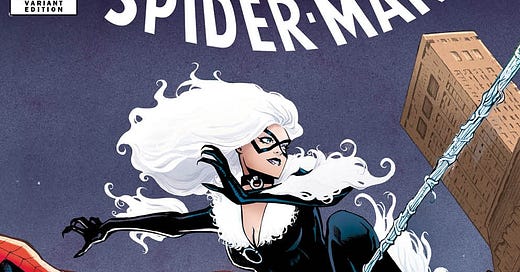





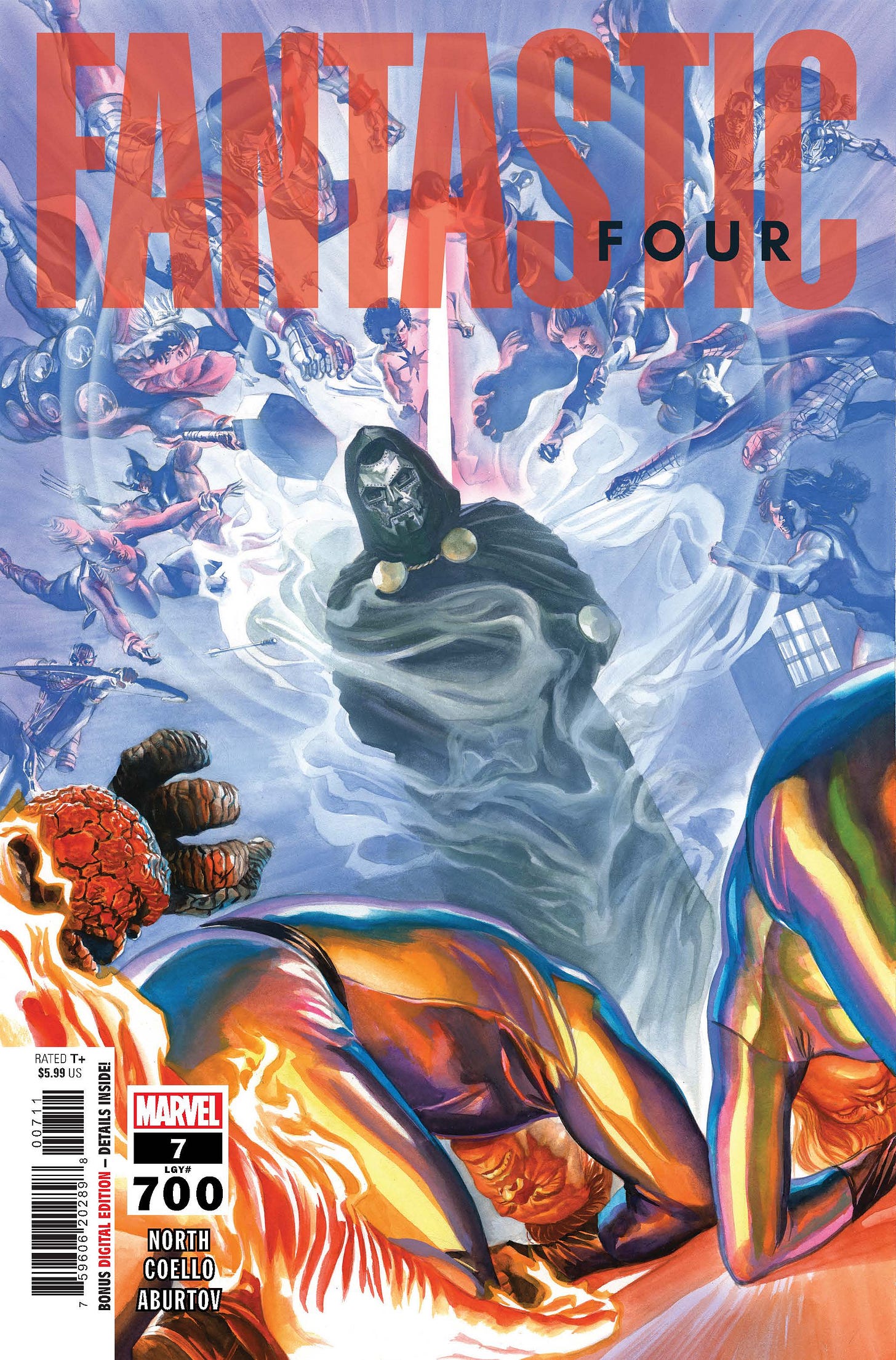
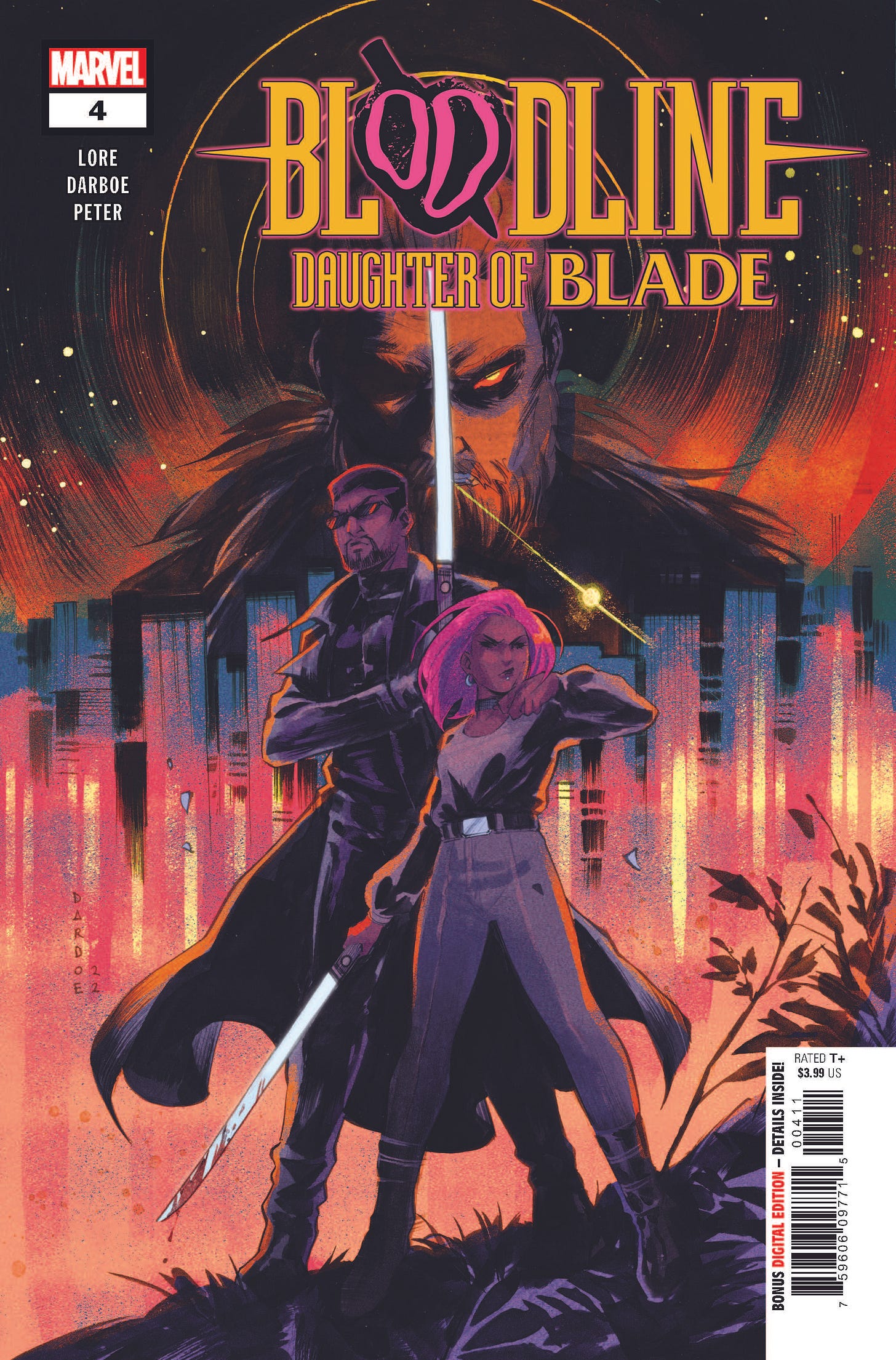

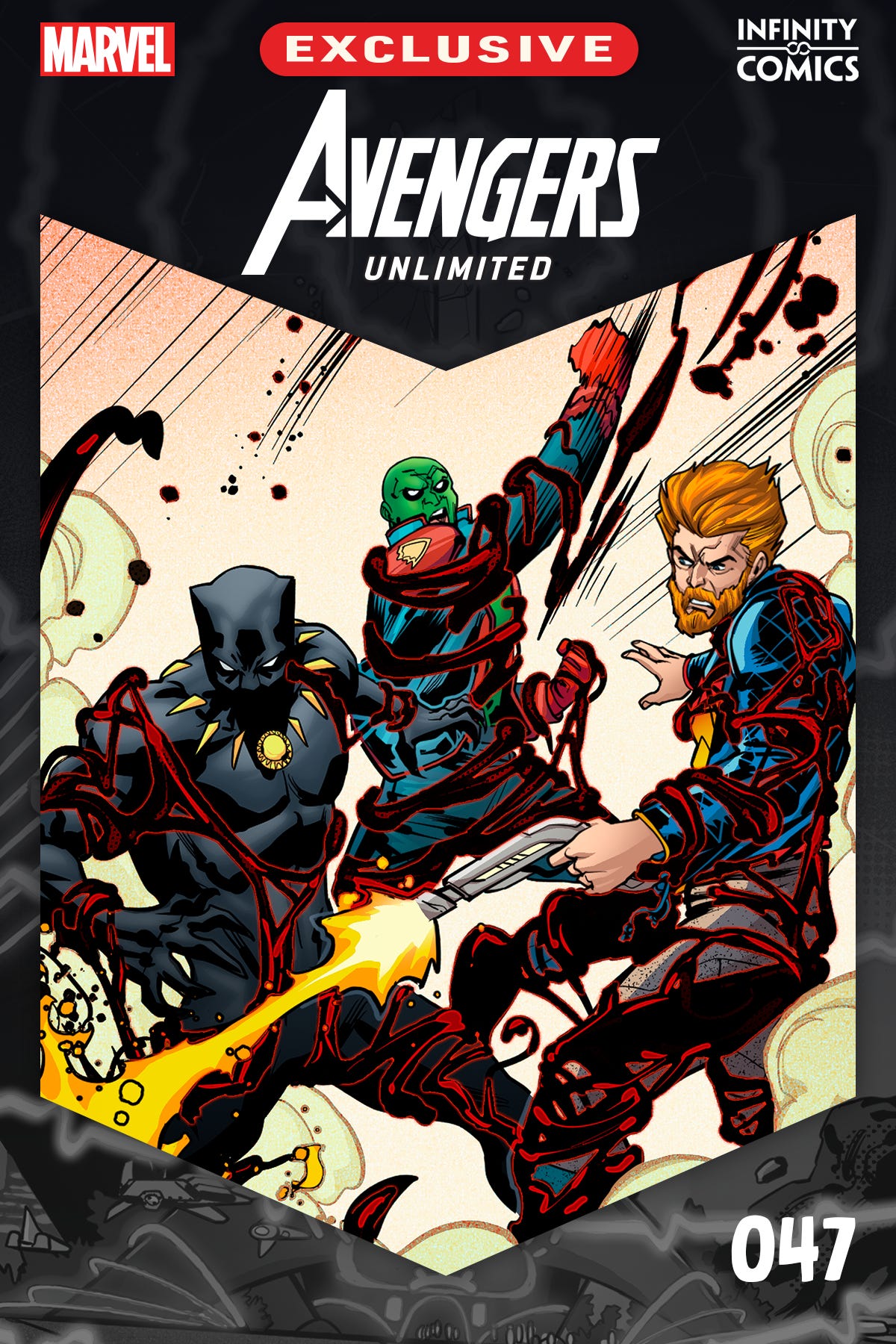
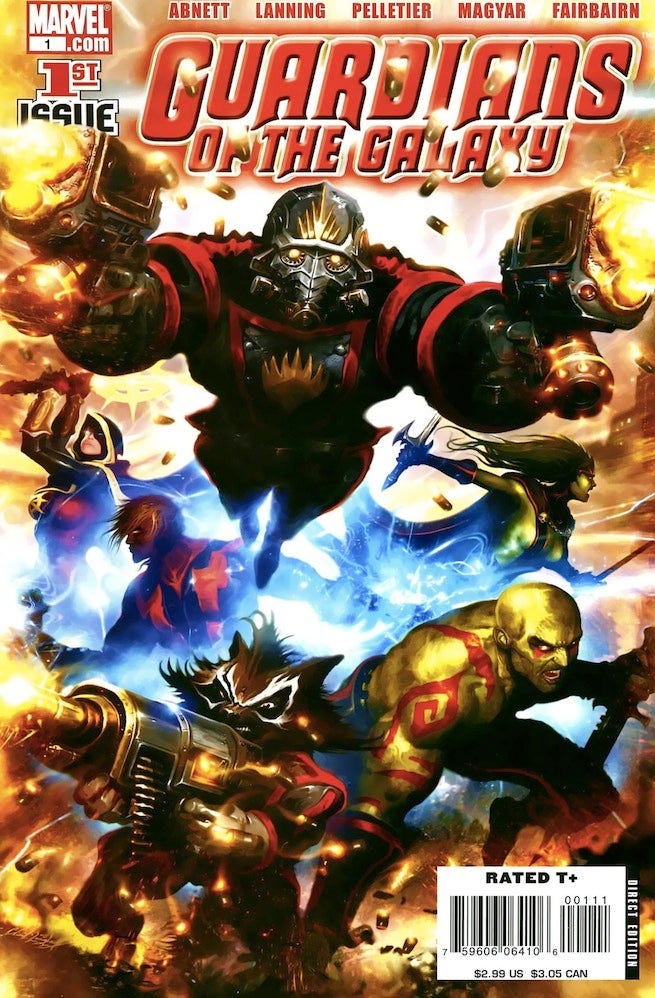
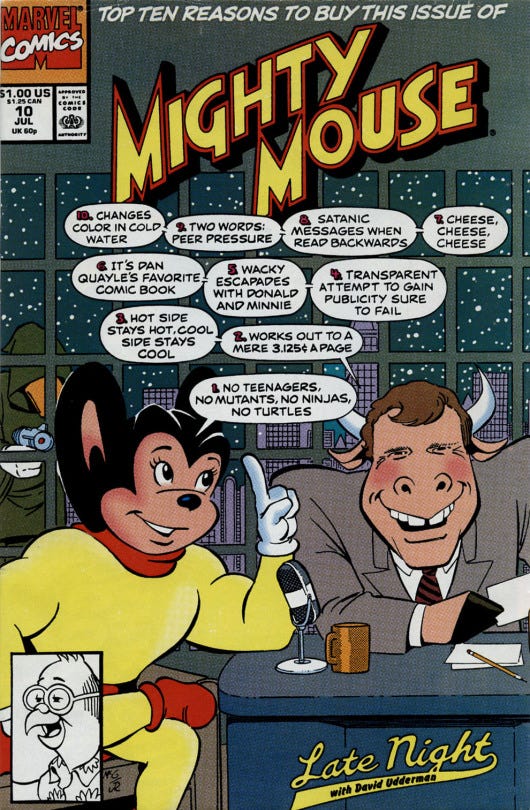
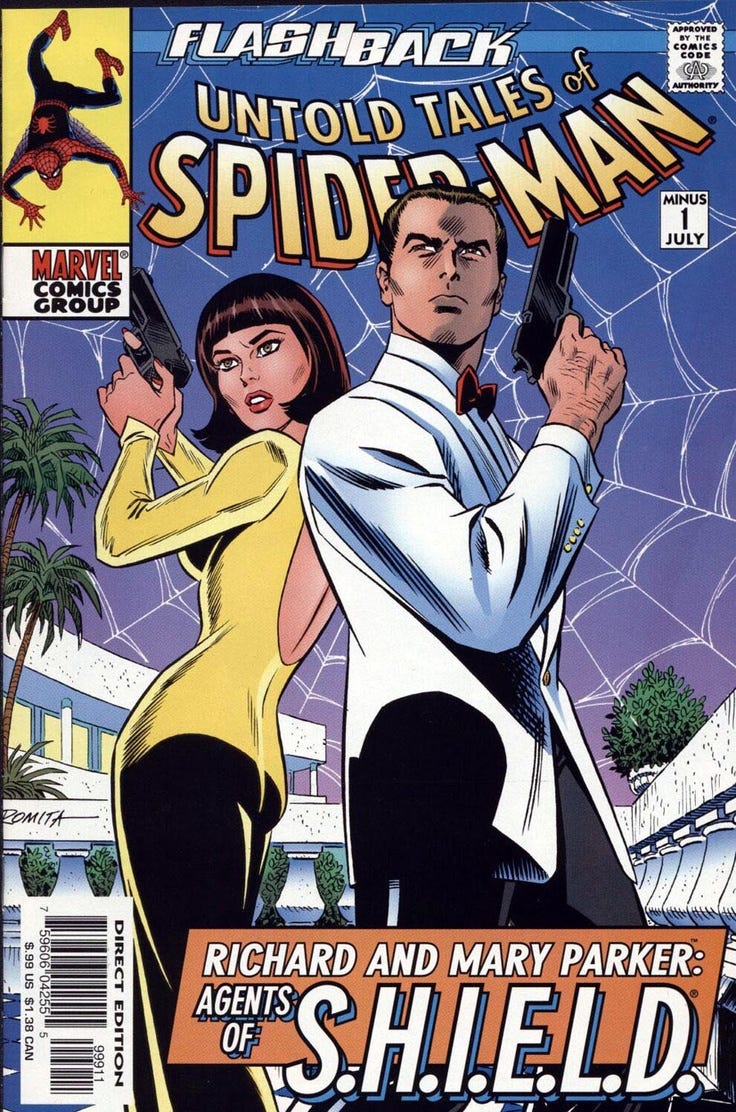


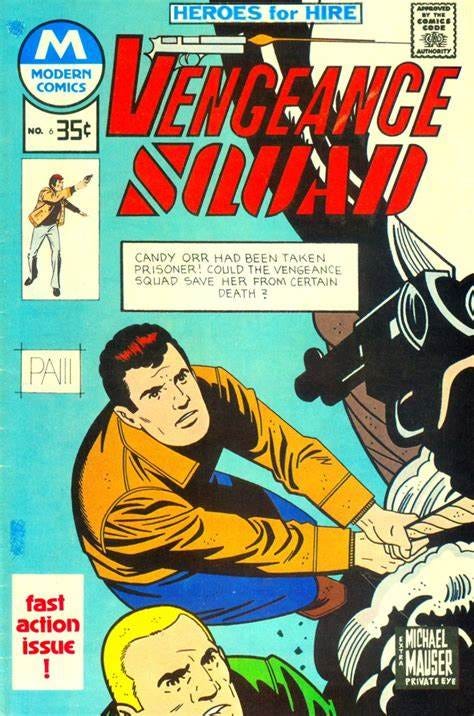
I think you’ve undersold the popularity Tom of the two Annihilation series, plus the spin off mini’s and the DnA Guardians book. Those were all phenomenally popular comics with the Marvel fan base, and still much loved. Plus seriously good comics. We found that Star-Lord was in the MU after all this time, Warlock, Bug and Rocket Racoon all returned after years away, and Groot was born after his two older appearances.
I wish Marvel were doing books like that now, I have the omnibuses. Some seriously good artists and storylines, and the Guardians book was far better than the Bendis one that followed, and any other series with them in released since.
Great”speil” on “story and … each individual comic being a complete unit of entertainment”. Thank you for recognizing this and taking the Marvel staff to task. I felt this issue in the last year or so reading Marvel (and other) comics. I hope your team takes this to heart and we see the changes in the near future.